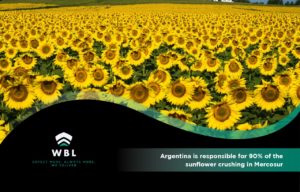Argentina is responsible for 90% of the sunflower crushing in Mercosur
Argentina maintains its clear leadership in South America as the main sunflower processing powerhouse. Forecast for the oilseed industry in Mercosur, with emphasis on sunflower.
The Argentine sunflower production chain begins its 2021/22 campaign in hopes of regaining lost ground. With a jump of more than 26% in the sown area, crop expectations are optimal, considering that an improvement in the production yield is also expected.
The recovery of sunflower production is expected to have a positive impact on the processing industry this year. Following the devastating 2019/20 marketing year (which coincides with the 2020 calendar year), the 2021 campaign bounced-back strongly, and the newly started 2021/22 campaign is expected to continue this virtuous path.
The oilseed processing industries of the Common Market of the South (Mercosur) have a strong position on a global level. On the one hand, it is expected that in the 2021/22 campaign, Mercosur will process about a third of the industrialized SB worldwide. This proportion is lower if we consider the sunflower crush in Mercosur, which is expected to represent only 6.4% of the global processing in this campaign.

Argentina will represent almost 90% of the sunflower that will be processed in Mercosur. This proportion has been sustained in recent years, although in past years Argentina’s participation was larger and with higher levels of industrialization, such as those observed in the 2000s.
Nonetheless, Argentina continues to be a leading player in sunflower processing in the global scheme. Our country is the fourth largest sunflower industrialist in the world, only behind Ukraine, Russia, and the European Union as a whole. The worldwide outlook for this industry is optimistic. Sunflower oil is expected to reach its highest level of world production and export this year, bolstered by good international price levels.
The crush infrastructure for the processing of oilseeds in Mercosur is heterogeneous in its size and developments over time. Although Brazil is the South American country with the largest number of processing plants, Argentina has the largest crush capacity in Mercosur.
One of the strategic advantages of the Argentine oilseed processing industry is its geographic concentration, with most of its plants located along the Upriver region. While more than 90% of Argentina’s processing capacity is concentrated in this region, Brazilian industries are distributed inland, among the states of Mato Grosso, Paraná, Rio Grande do Sul and Goiás regions, with little installed capacity used for sunflower processing.
For its part, the processing industry in Bolivia is concentrated mainly in the state of Santa Cruz de la Sierra, where more than 99% of the SB crop is located and 93% of the sunflower produced in our neighboring country. Meanwhile, the crush in Paraguay is distributed in the south of the country, with SB and sunflower production concentrated in the southeast of Paraguay, while its processing is carried out mainly in the southwest for export, mainly in the city of Villeta, on the banks of the Paraná. For its part, Uruguay concentrates a large part of its installed capacity in an important plant in Montevideo, its national capital.
Argentina allocates more than 7.4% of its crush capacity to sunflower. This way, it’s positioned only behind Uruguay in terms of the relative participation of sunflower in the industrialization of oilseeds. It’s worth highlighting that though our eastern neighbor allocates more than 58% of its processing industry to sunflower, it has a very small industry compared to the rest of the countries that make up Mercosur.
Based on the estimated processing volume in the 2021/22 campaign for both SB and sunflower, Mercosur expects and idle capacity crush close to 32.1% for its oilseed processing industry. Brazil expects robust processing levels, with idle capacity estimated to be just above 16%.
After its record peak of 43% idle capacity in 2020, this current year is expected to close with 41.4% of active installed capacity unused in Argentina. Although this number represents a fall compared to the levels of idleness that have been showing in recent years, idle capacity persists at high levels, above 40% as in recent years. It looks like the rest of the Mercosur countries expect idle capacity levels above 42% in all cases.
Source: https://bcr.com.ar/
Photo: REUTERS/Stringer
For more info visit
https://www.linkedin.com/company/wbl-shipping-agency/
